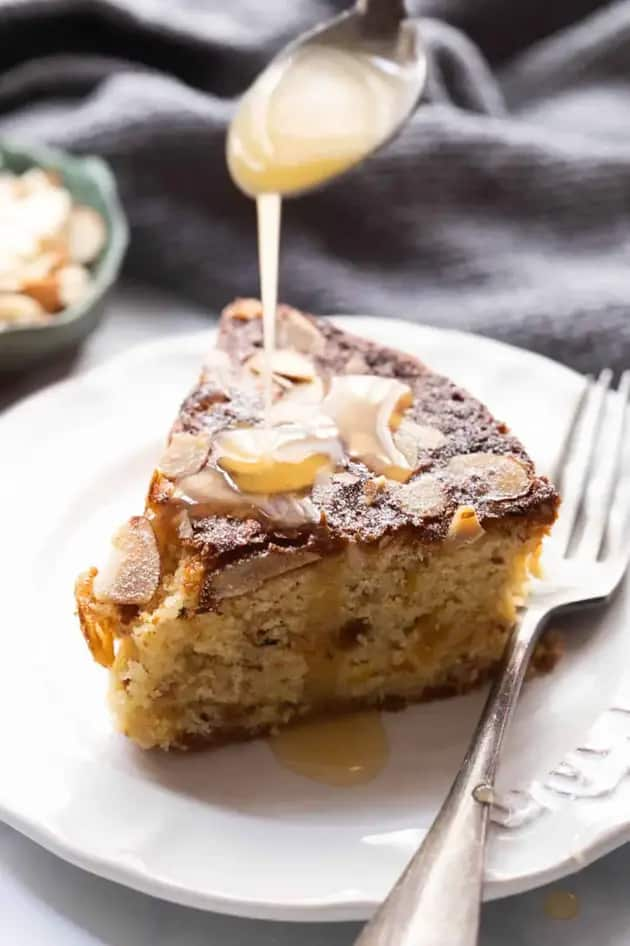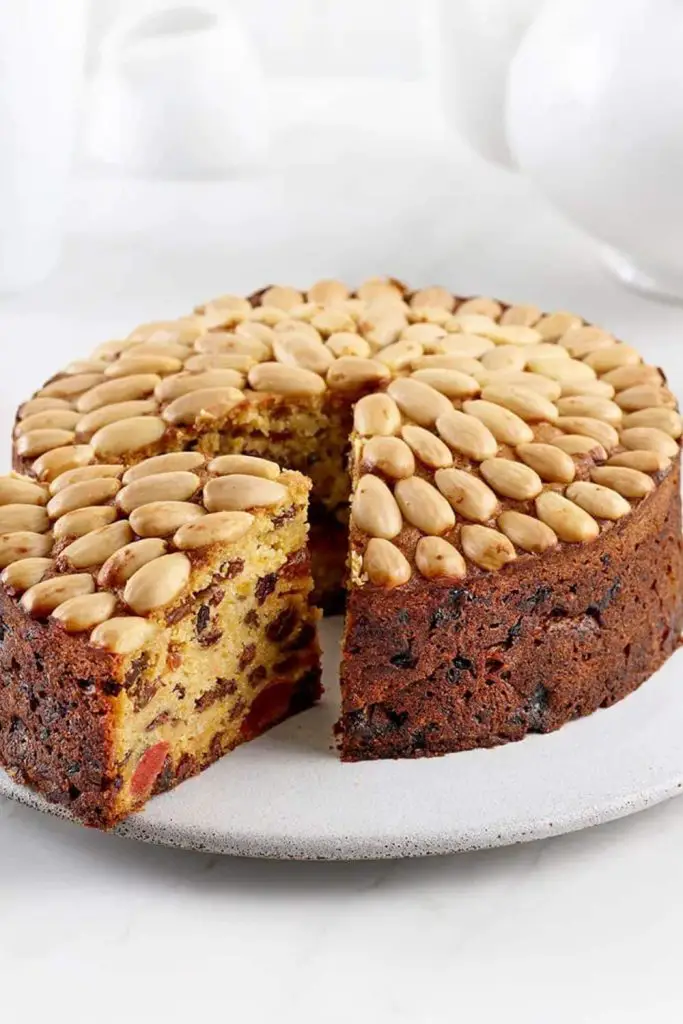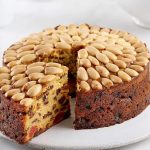Mary Berry Dundee Cake Recipe is a delightful, traditional Scottish cake made with a mix of dried fruits and topped with whole almonds arranged in a beautiful circular pattern. This moist, flavorful cake has a subtle citrusy kick, making it the perfect treat for any special occasion or cozy afternoon tea. With a preparation time of around 30 minutes and a baking time of 2 to 2.5 hours, this recipe is as rewarding to make as it is to enjoy!
What Is Mary Berry Dundee Cake?
Mary Berry’s Dundee Cake is a light, fruity cake originating from Dundee, Scotland. Unlike heavier fruitcakes, this version balances sweetness with a touch of citrus zest, featuring currants, sultanas, and a signature almond topping. Baked to golden perfection, it’s the ideal cake for anyone who loves traditional flavors with a modern twist.

Other Popular Recipes
Why You Should Try This Recipe
- Classic and Authentic: It’s a tried-and-true recipe from Mary Berry herself!
- Perfect for All Occasions: Elegant enough for holidays and simple enough for an everyday treat.
- Rich Yet Light: Delivers all the warmth of a fruitcake without the heaviness.
- Easy to Make: Straightforward instructions for bakers of all levels.
- Long-lasting Flavor: Tastes even better the next day as flavors deepen.
- Beautiful Presentation: The almond topping creates a stunning look, perfect for gifting.
Ingredients Needed to Make Mary Berry Dundee Cake
Gather these ingredients before you start. Using high-quality ingredients will enhance the flavor and texture of your Dundee Cake.
Dry Ingredients:
- 200g self-raising flour – This helps the cake rise slightly, giving it a light texture.
- 50g ground almonds – Adds a rich, nutty flavor and keeps the cake moist.
Fruits and Nuts:
- 175g currants
- 175g sultanas
- 50g mixed peel – Adds a nice, zesty flavor.
- 50g blanched almonds – Use these for the traditional decoration on top of the cake.
Other Ingredients:
- 175g butter (softened) – For a creamy, smooth texture.
- 175g caster sugar – Adds just the right amount of sweetness.
- 3 large eggs – Helps bind the ingredients together.
- Zest of 1 orange and 1 lemon – Gives the cake its signature citrusy kick.
- 1 tablespoon milk – Optional, to adjust the batter consistency if needed.
Equipment Needed
- Mixing bowls – For preparing and mixing ingredients.
- Electric mixer – To cream butter and sugar for a fluffy texture.
- 20cm (8-inch) round cake tin – The ideal size for this cake.
- Parchment paper – For easy removal after baking.
- Wire rack – To cool the cake evenly.
Instructions to Make Mary Berry Dundee Cake
Let’s break down the process step by step. Baking a Dundee Cake is simple, but the little details make all the difference!
Step 1: Prepare Your Ingredients and Preheat the Oven
- Preheat your oven to 150°C (300°F). A slow bake is key to getting a moist, evenly baked cake.
- Grease and line a deep 20cm (8-inch) round cake tin with parchment paper. This ensures your cake will come out smoothly once baked.
Step 2: Mix the Butter and Sugar
- In a large mixing bowl, beat the softened butter and caster sugar together until light and fluffy. This will take about 3-5 minutes and is essential for a soft, airy cake.
- Add the eggs one at a time, beating well after each addition. This helps to keep the batter smooth and prevents it from curdling.
Step 3: Add the Zest and Almonds
- Stir in the grated zest of one orange and one lemon for that lovely citrusy aroma.
- Fold in the ground almonds. They help to retain moisture, keeping the cake tender.
Step 4: Add the Flour and Dried Fruits
- Sift the self-raising flour into the mixture to avoid lumps and create a smooth batter.
- Add the currants, sultanas, and mixed peel, folding them gently into the mixture. Be sure to distribute them evenly for a consistent taste in every bite.
Step 5: Adjust with Milk (If Necessary)
- If your batter feels too thick, add a tablespoon of milk to adjust the consistency. The batter should be thick but still spreadable.
Step 6: Pour the Batter into the Tin and Decorate
- Spoon the mixture into your prepared cake tin and smooth the top with a spatula.
- Arrange the blanched almonds on top in concentric circles. This classic decoration not only looks beautiful but also adds a lovely crunch.
Step 7: Bake the Cake
- Bake for approximately 2-2.5 hours or until a skewer inserted into the center comes out clean. Remember, baking at a lower temperature is crucial for even cooking a moist cake.
- Check the cake after about 1.5 hours. If the top is browning too quickly, cover it loosely with foil to prevent burning.
Step 8: Cool and Serve
- Allow the cake to cool in the tin for about 15 minutes before transferring it to a wire rack.
- Let it cool completely before slicing. The flavors develop beautifully as they sit, so if you can wait a day, it will taste even better!

What Goes Well With Mary Berry Dundee Cake
This traditional cake has flavors that shine on their own but also pair wonderfully with a few accompaniments to elevate your experience.
- Hot Tea: The traditional pairing for this Scottish treat.
- Rich Coffee: Complements the cake’s nutty notes perfectly.
- Whipped Cream: A dollop adds creaminess to each bite.
- Fruit Preserves: Adds extra sweetness and flavor.
- Custard Sauce: Elevates it into a more indulgent dessert.
- Glass of Port: For a more sophisticated, adult pairing.
- Butter Spread: For a comforting, homestyle touch.
Expert Tips for Making the Best Mary Berry Dundee Cake
For perfect results, try these expert tips. Each small detail can make a big difference in achieving the perfect cake.
- Room-Temperature Ingredients: Ensure butter and eggs are at room temperature for smooth mixing.
- Beat Butter and Sugar Thoroughly: Cream until pale and fluffy for the best texture.
- Fold Gently: When adding flour and fruits, mix gently to avoid a dense cake.
- Check Almond Arrangement: Place almonds evenly for an attractive top.
- Bake Slowly: A low temperature helps prevent over-browning and dryness.
- Cover if Browning Too Quickly: Use foil to cover the cake halfway through if it’s getting too brown.
- Allow Cooling Time: Let the cake cool completely for easy slicing.
Easy Variations of Mary Berry Dundee Cake
If you’d like to personalize the cake, here are a few fun and simple variations to make it uniquely yours.
- Add Chopped Nuts: Use hazelnuts or walnuts for an extra crunch.
- Swap Citrus Zest: Try lime zest for a unique twist.
- Incorporate Spices: Add cinnamon or nutmeg for warmth.
- Try Glazed Fruit Topping: Use glazed cherries or other fruit toppings.
- Use Different Dried Fruits: Swap sultanas for dried apricots or cranberries.
Best Practices to Store Mary Berry Dundee Cake
Proper storage helps keep this cake delicious and moist. Follow these simple steps to enjoy it for days.
- Wrap Tightly: Use plastic wrap to keep it moist and fresh.
- Store in a Tin: Keeps the cake away from light and air.
- Avoid Fridge Storage: Chilling can dry out the cake.
- Freeze for Longer Storage: Wrap in plastic and foil before freezing.
- Keep in a Cool, Dark Place: Preserves flavor and texture best.
- Slice as Needed: Keeps more moisture in the cake.
- Store Almonds Separately (Optional): Prevents almonds from softening.
Best Practices to Reheat Mary Berry Dundee Cake
Reheating Dundee Cake is simple but can make all the difference in bringing out its flavors and keeping it moist.
- Use the Oven: Warm in a 150°C oven for a few minutes.
- Microwave with Caution: Heat on low power for brief intervals.
- Reheat Slices Only: Avoid reheating the entire cake to retain freshness.
- Cover with Foil: Prevents dryness during oven reheating.
How Can I Make Mary Berry Dundee Cake Healthier?
Looking to make a lighter, healthier version of this classic cake? Here are a few easy swaps you can try.
- Reduce Sugar: Use less sugar or try natural sweeteners.
- Use Whole-Wheat Flour: For added fiber, replace some of the self-raising flour.
- Add Extra Fruit: Incorporate more dried fruit for natural sweetness.
- Swap Butter for Coconut Oil: A lighter alternative that adds flavor.
- Add a Protein Boost: Mix in a tablespoon of almond or protein powder.
Nutrition Value (Per Serving):
- Calories: 320 kcal
- Fat: 17g
- Carbohydrates: 35g
- Protein: 5g
- Fiber: 2g
- Sugar: 22g
FAQs
What Is a Dundee Cake?
The Dundee Cake is a famous Scottish fruitcake that dates back to the 19th century. Named after the Scottish city of Dundee, this cake stands out with its light, zesty flavor and characteristic whole-almond decoration on top. Unlike other fruitcakes, which can be quite dense, Dundee cake is lighter, with a subtle sweetness and a hint of citrus. It’s perfect with a cup of tea, making it a wonderful treat for the holiday season or anytime you’re craving a classic dessert.
How Do I Keep My Dundee Cake Moist?
To keep your Dundee Cake moist, wrap it tightly in plastic wrap after it has cooled completely and store it in an airtight container. You can also add a light brush of sugar syrup over the cake before wrapping if you want extra moisture. Storing it in a cool, dark place helps preserve its texture and flavor.
Can I Make Dundee Cake Ahead of Time?
Yes, Dundee Cake actually tastes better after resting for a day or two as the flavors develop beautifully. Make it up to a week in advance, and store it wrapped in plastic wrap and kept in an airtight container for the best results.
What Can I Use Instead of Mixed Peel in Dundee Cake?
If you prefer a different flavor or don’t have a mixed peel, you can substitute it with dried cranberries, apricots, or raisins. These alternatives add sweetness and texture without changing the cake’s overall structure.
How Do I Know When My Dundee Cake is Fully Baked?
Dundee Cake is ready when a skewer inserted into the center comes out clean, which usually takes 2 to 2.5 hours. If the top begins to brown too quickly, cover it loosely with foil for the remainder of the baking time to prevent over-browning.
What is the Difference Between Dundee Cake and Fruit Cake?
The main difference between Dundee Cake and traditional fruit cake lies in their texture and ingredients. Dundee Cake is lighter and typically contains a mix of currants, sultanas, and citrus zest, whereas fruit cake is often denser and includes a broader variety of dried fruits and sometimes even alcohol. Dundee Cake is also decorated with whole almonds arranged in a circular pattern, which gives it its distinctive appearance.
What Does Mary Berry Use Instead of Butter?
In some recipes, Mary Berry substitutes butter with margarine or a baking spread, especially to achieve a lighter texture. However, in her traditional Dundee Cake recipe, she typically uses butter for a richer flavor and moist crumb.
What is Another Name for Dundee Cake?
Dundee Cake is sometimes referred to simply as “Scottish fruitcake.” While it’s technically a type of fruitcake, its specific ingredients and almond topping set it apart as a unique variety within Scottish cuisine.
What Cake Did Churchill Like?
Winston Churchill was famously fond of Dundee Cake. This Scottish treat was often served to him, and he enjoyed its balanced sweetness, light texture, and nutty almond topping.
What is Special About Dundee Cake?
Dundee Cake is unique for its light texture, citrus-infused flavor, and classic almond decoration on top. Originating from Dundee, Scotland, it stands out from other fruitcakes by being less dense and having a distinctive, visually appealing pattern made with whole almonds.
Final Words
Mary Berry Dundee Cake is more than just a fruitcake; it’s a timeless treat with a soft crumb, rich flavor, and beautiful presentation. Make it for your family or give it as a gift, and this classic Scottish cake is sure to impress. Enjoy the rewarding process of baking, and savor each delicious bite with a cozy cup of tea!
More Recipes By British Baking Recipes
Print
Mary Berry Dundee Cake
- Prep Time: 30
- Cook Time: 135
- Total Time: 2 hours 45 minutes
- Yield: 8 1x
- Category: Dessert
- Method: Baking
- Cuisine: Scottish
Description
Mary Berry’s Dundee Cake is a light, fruity cake originating from Dundee, Scotland. Unlike heavier fruitcakes, this version balances sweetness with a touch of citrus zest, featuring currants, sultanas, and a signature almond topping. Baked to golden perfection, it’s the ideal cake for anyone who loves traditional flavors with a modern twist.
Ingredients
Gather these ingredients before you start. Using high-quality ingredients will enhance the flavor and texture of your Dundee Cake.
Dry Ingredients:
- 200g self-raising flour – This helps the cake rise slightly, giving it a light texture.
- 50g ground almonds – Adds a rich, nutty flavor and keeps the cake moist.
Fruits and Nuts:
- 175g currants
- 175g sultanas
- 50g mixed peel – Adds a nice, zesty flavor.
- 50g blanched almonds – Use these for the traditional decoration on top of the cake.
Other Ingredients:
- 175g butter (softened) – For a creamy, smooth texture.
- 175g caster sugar – Adds just the right amount of sweetness.
- 3 large eggs – Helps bind the ingredients together.
- Zest of 1 orange and 1 lemon – Gives the cake its signature citrusy kick.
- 1 tablespoon milk – Optional, to adjust the batter consistency if needed.
Instructions
Step 1: Prepare Your Ingredients and Preheat the Oven
- Preheat your oven to 150°C (300°F). A slow bake is key to getting a moist, evenly baked cake.
- Grease and line a deep 20cm (8-inch) round cake tin with parchment paper. This ensures your cake will come out smoothly once baked.
Step 2: Mix the Butter and Sugar
- In a large mixing bowl, beat the softened butter and caster sugar together until light and fluffy. This will take about 3-5 minutes and is essential for a soft, airy cake.
- Add the eggs one at a time, beating well after each addition. This helps to keep the batter smooth and prevents it from curdling.
Step 3: Add the Zest and Almonds
- Stir in the grated zest of one orange and one lemon for that lovely citrusy aroma.
- Fold in the ground almonds. They help to retain moisture, keeping the cake tender.
Step 4: Add the Flour and Dried Fruits
- Sift the self-raising flour into the mixture to avoid lumps and create a smooth batter.
- Add the currants, sultanas, and mixed peel, folding them gently into the mixture. Be sure to distribute them evenly for a consistent taste in every bite.
Step 5: Adjust with Milk (If Necessary)
- If your batter feels too thick, add a tablespoon of milk to adjust the consistency. The batter should be thick but still spreadable.
Step 6: Pour the Batter into the Tin and Decorate
- Spoon the mixture into your prepared cake tin and smooth the top with a spatula.
- Arrange the blanched almonds on top in concentric circles. This classic decoration not only looks beautiful but also adds a lovely crunch.
Step 7: Bake the Cake
- Bake for approximately 2-2.5 hours or until a skewer inserted into the center comes out clean. Remember, baking at a lower temperature is crucial for even cooking a moist cake.
- Check the cake after about 1.5 hours. If the top is browning too quickly, cover it loosely with foil to prevent burning.
Step 8: Cool and Serve
- Allow the cake to cool in the tin for about 15 minutes before transferring it to a wire rack.
- Let it cool completely before slicing. The flavors develop beautifully as they sit, so if you can wait a day, it will taste even better!




